Мир путешествий в фотографияхТестирование объектива Tamron SP 70-200mm F2.8 Di VC USD. Светосильный теле-зумНавигация по записямКалендарь записейПопулярное
Содержание
Ease of Use
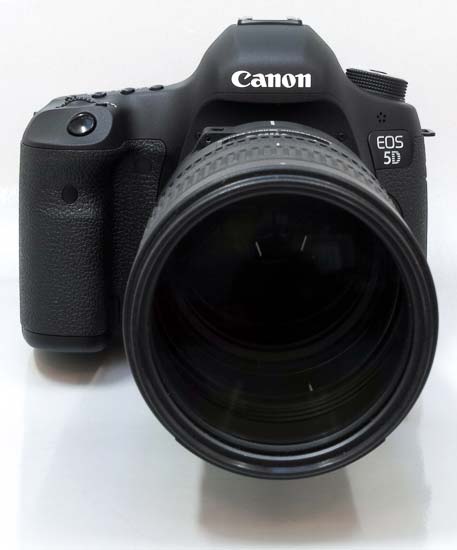 The Tamron SP 70-200mm F/2.8 Di VC USD lens mounted on a Canon EOS 5D Mk III
The Tamron SP 70-200mm F/2.8 Di VC USD lens mounted on a Canon EOS 5D Mk III
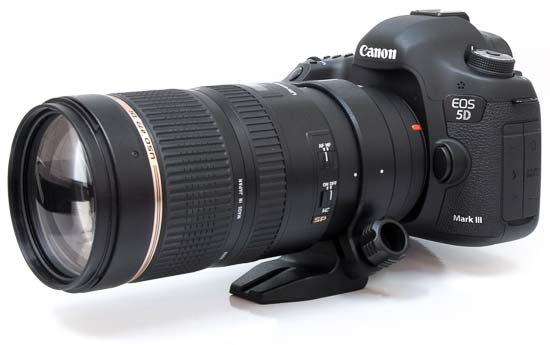 The Tamron SP 70-200mm F/2.8 Di VC USD lens, isometric view
The Tamron SP 70-200mm F/2.8 Di VC USD lens, isometric view
 The Tamron SP 70-200mm F/2.8 Di VC USD lens, isometric view
The Tamron SP 70-200mm F/2.8 Di VC USD lens, isometric view
For such a fast telephoto zoom lens, the Tamron SP 70-200mm F/2.8 Di VC USD is predictably quite big and bulky, measuring almost 20cms in length and wighing in at just under 1.5Kg with the detachable tripod mount attached. While you can use it on a smaller APS-C body, it won’t balance very well (and the focal length will also change) — as demonstrated by the images above, it’s a much better match for a professional-grade, full-frame camera like the 5D Mark III, where it feels better balanced.
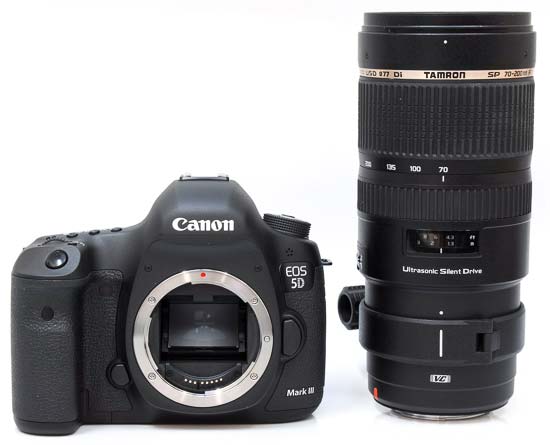 The Tamron SP 70-200mm F/2.8 Di VC USD lens alongside the Canon EOS 5D Mark III
The Tamron SP 70-200mm F/2.8 Di VC USD lens alongside the Canon EOS 5D Mark III
Build quality is very good, despite Tamron traditionally offering lenses at the cheaper end of the market. The more premium-priced Tamron SP 70-200mm F/2.8 Di VC USD feels solid in your hand, even if the outer barrel and the filter thread appear to be made from plastic.
Front of the Tamron SP 70-200mm F/2.8 Di VC USD lens
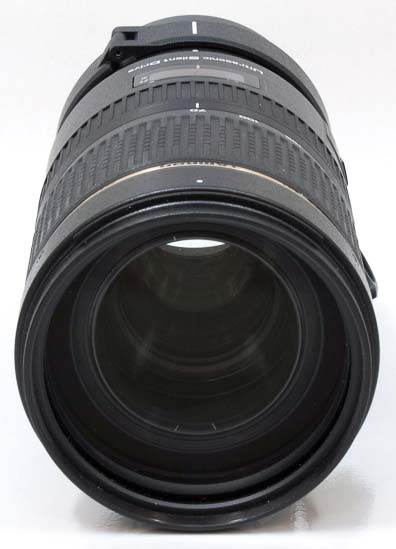 Front of the Tamron SP 70-200mm F/2.8 Di VC USD lens
Front of the Tamron SP 70-200mm F/2.8 Di VC USD lens
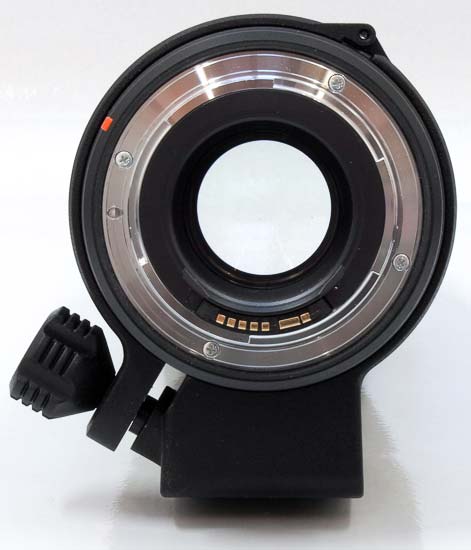 Rear of the Tamron SP 70-200mm F/2.8 Di VC USD lens
Rear of the Tamron SP 70-200mm F/2.8 Di VC USD lens
The zoom ring is generously wide and has a ridged, rubberised grip band. The lens doesn’t extend at any point when you zoom out from 70mm and the filter ring doesn’t rotate, good news for filter users.
The focusing ring is much narrower, making it difficult to locate in a rush, but it is well damped. There’s a distance scale that runs from the closest distance of 1.3m to infinity, but no depth of field scale. An AF/MF switch on the side of the lens makes it easy to switch between the two focusing systems.
 Side of the Tamron SP 70-200mm F/2.8 Di VC USD lens
Side of the Tamron SP 70-200mm F/2.8 Di VC USD lens
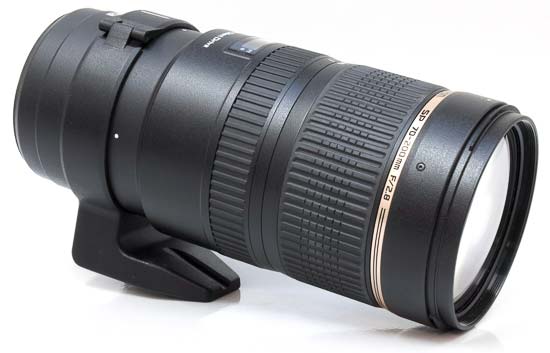 Side of the Tamron SP 70-200mm F/2.8 Di VC USD lens
Side of the Tamron SP 70-200mm F/2.8 Di VC USD lens
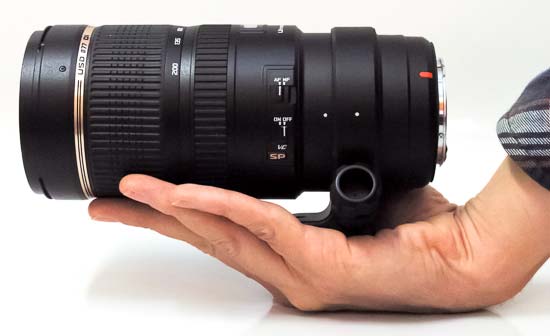 The Tamron SP 70-200mm F/2.8 Di VC USD lens in-hand
The Tamron SP 70-200mm F/2.8 Di VC USD lens in-hand
The final control is the VC On / Off switch, which turns the lens’ built-in Vibration Compensation on and off. This is a big selling point for the Tamron SP 70-200mm F/2.8 Di VC USD. In practice we found it offered around 3 f-stops of compensation, obviously dependant upon your own particular hand-holding technique, making it easier to use the lens in low-light.
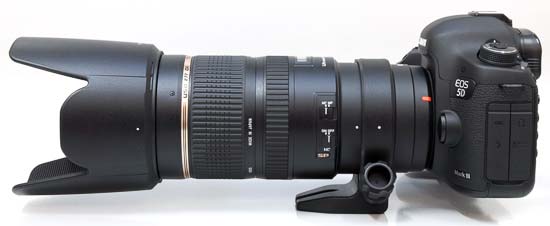 The Tamron SP 70-200mm F/2.8 Di VC USD lens fitted with the lens hood and the detachable tripod mount
The Tamron SP 70-200mm F/2.8 Di VC USD lens fitted with the lens hood and the detachable tripod mount
The lens is supplied with lens caps and a large flower-shaped lens hood — there’s no bag included. The filter size is 77mm.
Auto-focus
The Tamron SP 70-200mm F/2.8 Di VC USD features a USD (Ultrasonic Silent Drive) that allows near-silent auto-focusing. Importantly, this solution allows instant manual override even when the focus mode switch is in the AF position. Focusing is fully internal, meaning the length of the lens always remains constant. In use, we found the focusing to be indeed very quiet, and pretty fast — but definitely not instantaneous — with the lens mounted to a Canon EOS 5D Mk III body.
Chromatic Aberrations
Chromatic aberrations, typically seen as purple or blue fringes along contrasty edges, are impressively well controlled with this lens — the examples below show the worst-case scenario.
The Tamron SP 70-200mm F/2.8 Di VC USD offers a classic focal range for full-frame DSLR owners.
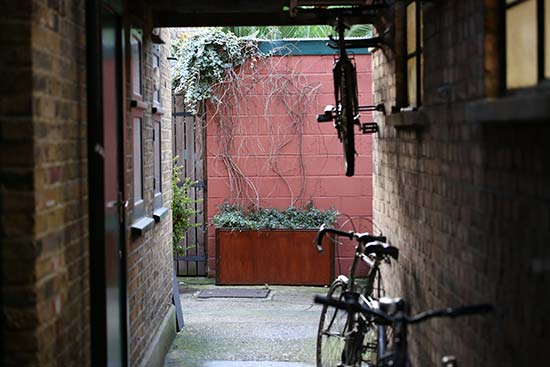 70mm
70mm
 200mm
200mm
Light Fall-off
With the Tamron SP 70-200mm F/2.8 Di VC USD wide open at f/2.8, you can see some very noticeable light fall-off in the corners at both ends of the zoom range. Stopping down helps, although to completely get rid of this phenomenon, you will need to use an f-stop of f/5.6 or smaller.


Macro
The Tamron SP 70-200mm F/2.8 Di VC USD is not a macro lens. The close-focus point is at 1.3m from the film/sensor plane. The following example illustrates how close you can get to the subject with the lens set to 200mm to aid magnification, in this case a CompactFlash card.
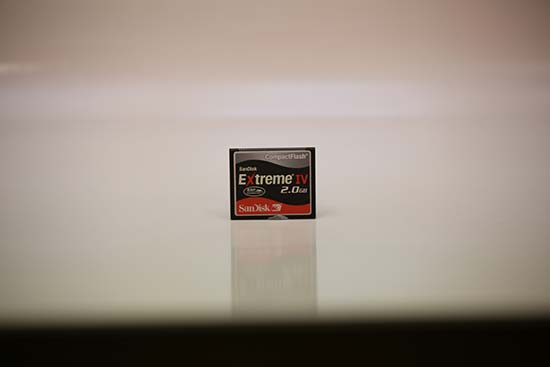 Close-up performance
Close-up performance
Bokeh Examples
Bokeh is a word used for the out-of-focus areas of a photograph, and is usually described in qualitative terms, such as smooth / creamy / harsh etc. One of the reason to buy a fast lens is to be able to isolate the subject from the background, which is normally very hard to do with an ultrawide lens. Tamron was apparently very much aware of this requirement, as they employed an iris diaphragm with 9 rounded blades for a pleasing rendering of the out-of-focus highlights. Based on what we have seen, we can say that they largely succeeded. Below you’ll find some examples, but you are also encouraged to check out our sample images.
Sharpness
In order to show you how sharp this lens is, we are providing 100% crops on the following pages.
- Ease of Use
- Sharpness: 1
-
Cont… 2
-
Cont… 3
-
Cont… 4
- Sample Images
- Lens Specs
- Rating & Conclusion
- Review Roundup
- Ease of Use
- Sharpness: 1
-
Cont… 2
-
Cont… 3
-
Cont… 4
- Sample Images
- Lens Specs
- Rating & Conclusion
- Review Roundup
Introduction
|
B&H Photo — Video — Pro Audio I buy only from . I can’t vouch for below. |
This Image-Stabilized Tamron 70-200mm f/2.8 is half the price of Canon or Nikon and works great. Feel free to read the rest of this review, but for all practical purposes this lens takes the same pictures as the Canon or Nikon lenses, with the gotcha that there are no lens profiles so you’ll have no option for automatic in-camera distortion correction, and on Canon only there will be no correction of lateral color fringes or corner falloff (Nikons correct lateral color and falloff with any lens, no profile needed).
Look at my ; they’re super-sharp. If an extra thousand dollars in your pocket matters to you, by all means consider this lens instead of the Canon or Nikon lens. What you lose isn’t so much picture quality as the potential for the camera you buy ten years from now not working with this lens, but if you’re considering this lens today you’re probably not worried about ten or twenty years from now. Even the reviews at Amazon love it.
Just grab the genuine mechanical focus ring at any time for instant manual-focus override.
This is a very nice lens, complete with internal zooming. Nothing moves externally as you zoom and you can flick the genuine mechanical focus ring at any time for instant manual-focus override.
Good
● Sharp.
● Half the price of Canon or Nikon’s similar lenses.
● Same optical performance as Canon’s or Nikon’s 70-200/2.8s.
● Fast and nearly silent autofocus.
● Great stabilization.
Missing
● No lens profiles for in-camera corrections. Nikons can correct any lens for lateral chromatic aberrations and falloff without a profile, but Canon can’t correct these without a profile. No camera can correct this lens’ distortion without a profile — and neither Canon nor Nikon are going to offer profiles for a Tamron lens.
Sample Images
All these images are from BASIC JPGs; no RAW files, NORMAL or FINE JPGs were used.
Boulevards, 13 April 2018, Friday. Nikon D850, Tamron 70-200mm f/2.8 G2 at 120mm at f/5.6 at 1/250 at Auto ISO 64, Perfectly Clear. bigger or full-resolution or camera-original file.
Sofie, 18 April 2018, Wednesday. Cropped from horizontal Nikon D850 file, Tamron 70-200mm f/2.8 G2 at 125mm at f/8 at 1/250 at Auto ISO 64, as shot. bigger or camera-original file.
Zoey, 18 April 2018, Wednesday. Cropped from horizontal Nikon D850 file, Tamron 70-200mm f/2.8 G2 at 200mm at f/8 at 1/250 at Auto ISO 64, as shot. bigger or camera-original file.
Full-Frame VC G2 2017-

Tamron 70-200mm f/2.8 VC G2 (77mm filters, 52.1 oz./1,477g, 3.1’/0.95m close focus, about $1,299) bigger. I got my Nikon version at B&H. I’d also get the Nikon version at Adorama or at Amazon. There is a Canon version at B&H, which I’d also get at Adorama or at Amazon.
This ad-free websites biggest source of support is when you use those or any of when you get anything, regardless of the country in which you live. Tamron does not seal its boxes in any way, so never buy at retail or any other source not on since you’ll have no way of knowing if you’re missing accessories, getting a defective, damaged, returned, , store demo or used lens. Get yours only from the for the best prices, service, return policies and selection. Thanks for helping me help you! Ken.
April 2018 Sony Zeiss Nikon Canon Fuji LEICA All Reviews
Nikon 70-200mm f/2.8 FL VR FX (check price)
Nikon 80-200mm f/2.8D FX (check price)
Canon 70-200mm f/2.8 L IS II (check price)
Canon 100-400mm L IS II (check price)
Getting a Legal USA Version
This section applies in the USA only.
In the USA, be sure the serial number on your lens (in tiny black-on-black numbers on the bottom of the zoom ring) matches the serial number on the top of the box and on the warranty papers inside the box, and be sure your box has this six-year USA hologram sticker:

Tamron USA hologram sticker. bigger.
If not, you got ripped off with a gray market version from another country. This is why I never buy anyplace other than from my . You just can’t take the chance of buying elsewhere, especially at any retail store, because non-USA versions have no warranty in the USA, and you won’t even be able to get firmware or service for it — even if you’re willing to pay out-of-pocket for it when you need it!
If a gray market version saves you $400 it may be worth it, but for $200 or less I wouldn’t risk having no warranty or support.
Always be sure to check your box while you can still return it, or just don’t buy from unapproved sources or at retail so you’ll be able to have your camera serviced and get free updated firmware as needed.
Get yours from the and you won’t have a problem, but if you take the risk of getting yours elsewhere, be sure to check everything while you still can return it.
Tamron SP 70-200mm F2.8 Di VC USD Introduction
The Tamron SP 70-200mm F/2.8 Di VC USD is a fast telephoto zoom lens for Canon, Sony and Nikon full-frame DSLR cameras. This compact lens features a constant aperture of f/2.8 throughout the range, Vibration Compensation (VC) technology, and an ultrasonic focus motor for quiet AF operation, and a moisture-sealed construction. The optical formula comprises 23 lens elements in 17 groups, including one XLD (Extra Low Dispersion) glass and four LD (Low Dispersion) elements, and an iris diaphragm with nine rounded aperture blades. The Tamron SP 70-200mm F/2.8 Di VC USD lens officially retails for £1,399.99 / $1499.
Compared
NEW: Best 70-200mm f/2.8 Lenses Compared.
This Tamron is half the price, and optically just as good as the lenses from Canon and Nikon.
What you lose for paying only half as much is that this Tamron is built only to good consumer levels, while the Nikon 70-200mm f/2.8 FL VR FX and Canon 70-200mm f/2.8 L IS II are built to extraordinary professional standards with mostly metal barrels and metal filter threads. Nikon and Canon’s 70-200/2.8s are built to withstand a lifetime of full-time professional environmental and physical abuse, while this Tamron is designed for normal people who take care of their equipment.
Every non-camera-brand product has the potential to be, or become, incompatible with your camera. While it probably will be perfect with your camera today (and if it’s not and you get yours from an you can send it back for a 100% cash refund), there’s no telling if it will be compatible with whatever camera you might buy 10 years from now. I’m still using my Canon and Nikon 80-200mm f/2.8 lenses that I bought back in the 1980s and 1990s with my newest digital cameras, but no one can be sure if this Tamron lens will work with cameras 10 years from now. While off-brand makers all smile and try to reassure you today that they’ll be around in the future to update lenses, experience has shown that these makers just walk away when it comes to trying to update 10 year old lenses.
Let’s be serious: The Nikon 70-200mm f/2.8 FL VR FX costs $2,800 as I write this. That’s $1,500 more than this lens. You could buy this Tamron today, and if in ten years it stops working, buy another brand-new version from Tamron and still be way ahead.
Usage

Tamron 70-200mm f/2.8 VC G2. bigger.
VC MODE/1
This selects what kind of Image Stabilization you’re getting.
Mode 1, the top position, is the usual setting. It stabilizes your photos, as well as your viewfinder image.
Mode 2 is for panning.
Mode 3 offers even better picture stabilization than Mode 1, but it may make the viewfinder image look shakier because it’s optimizing itself to stabilize the captured image instead of also stabilizing the pre-exposure viewfinder image.
Use Mode 1, unless you don’t mind a shakier viewfinder image and aren’t getting the results you want in Mode 1. Mode 2 is only for panning.
VC / ON (OFF)
This activates or deactivates Image Stabilization.
Always leave it on (VC/ON), except if you are on a sturdy tripod (OFF).
AF (MF)
This selects auto (AF) or manual focus (MF).
Always leave it at AF, at which setting you can move the focus ring at any time for instant override.
Only set it to MF if you want to lock it in manual focus.
FULL / ∞-3m
This is a focus limiter that, in the ∞-3m setting, doesn’t let the lens focus any closer than 3 meters (10 feet).
Leave this at FULL, unless the lens is racking all the way in and out hunting for the subject, which you know is at least 3m/10′ away. I doubt you’ll ever need this, unless you’re shooting distant things through an obstruction.
Compatibility
Caution
No camera maker authorizes Tamron to make lenses for their cameras, and no camera maker authorizes you to use this lens on their cameras. If it doesn’t work, talk to Tamron, not to Nikon or Canon.
While it seems very compatible, there is always the potential that something won’t work on your camera, especially in the future as newer camera models come out.
No worries, so long as you get yours from an you can return it for a full cash refund if you don’t love it or it doesn’t work when you get your lens.
Canon
It should work flawlessly on every Canon DSLR and every Canon 35mm autofocus (EOS) camera ever made since 1987.
It should work on , but only if you use the EOS-M adapter.
Nikon
It should work perfectly on all FX Nikons, and should work well on DX Nikon models introduced since about 2007.
I tried it on my D3 that I bought back in 2007, and everything works great, as well as on my 2018 D850.
This Tamron 70-200 has a new which won’t work on camera models introduced before about 2007.
It won’t work properly on older DSLRs or any ; they won’t be able to work with the electronic diaphragm and will only shoot wide-open. If you don’t mind shooting wide-open, go ahead and shoot it on older cameras if you like. Even on a 1959 Nikon F you can focus and zoom manually and shoot wide open.
It’s useless on my 2006 Nikon D40, which simply shows an Error.
I tried it on my 1990s Nikon F5, and it autofocuses and stabilizes just fine, but it only shoots at f/2.8.
On my 2005 D2HS autofocus and VR work fine, but it only shoots at f/2.8 regardless of how you set the camera, so often you’ll get overexposure unless you shoot in A or M mode and set f/2.8.
Autofocus, VR and the diaphragm don’t work on my 1980s Nikon F4. I’d have to focus manually, lose VR and have to shoot at f/2.8.
YES: As of January 2018, should work only on the:
D5, D4, D4s, D3, D3s, D3P, D3x, Df,
D850, D810, D800/e, D750, D700, D610, D600,
D500, D300, D300s,
D7000, D7100, D7200, D7500,
D5600, D5500, D5300, D5200, D5100, D5000,
D3400, D3300, D3200, D3100,
Nikon 1 J1, J2, J3, J4 with FT-1, Nikon 1 V1, V2, V3 with FT-1, and Nikon 1 S1, S2 with FT-1.
NO: lenses will not work on the
D1 or D2 series,
D100, D200, D90, D80, D70 series,
D60, D50, D40 series, or the D3000, and will not work on any . The diaphragm will stay wide-open, which may or may not be a problem for you. In the case of tele lenses this isn’t much of a problem because we usually shoot long lenses wide-open, in which case these lenses are compatible with everything.
This won’t work with any of the Pronea cameras either— but who cares?
See for more. Honestly half of Nikon’s current catalog of lenses won’t work on half their new cameras today, so I don’t know that this lens will have any more problems than any other Nikon lens. Just be sure to buy only from an so you’ll have the option of a 100% cash refund return if it just doesn’t work on your camera. Nikon isn’t Canon that takes one sentence to say «Compatible with everything since 1987;» Nikon is a patchwork of shame today when it comes to compatibility.
Sony
There is no Sony version. I have no idea how well using an adapter with the Canon version of this Tamron will work on Sony; you’re really asking for trouble.
For Sony, get any of the newest Sony 70-200mm f/2.8 GM OSS, Sony 70-200mm f/4 G OSS or Sony FE 70-300mm G FE OSS lenses instead.
This is a DSLR lens, not a mirrorless lens.
Specifications
Name
Tamron calls this the Tamron SP 70-200mm f/2.8 Di VC USD G2:
SP: Special Performance; Tamron has called most of their lenses this since at least the 1970s.
Di: Works on digital cameras — so?
VC: Vibration control (Image Stabilization).
USD: Ultrasonic Silent Drive autofocus motor.
G2: Tamron’s second 70-200/2.8 VC.
Also has:
∅77: 77mm filter thread.
Optics
23 elements in 17 groups.
5 LD Low Dispersion elements, which help reduce secondary axial chromatic aberration.
1 XLD Extra-Low Dispersion elements, which help reduce secondary axial chromatic aberration.
No aspherical elements.
No high refractive-index elements.
Fluorine coating to resist dirt and smudges.
Internal zoom; nothing moves externally as zoomed.
Nikon: FX and DX (digital cameras only).
Canon: Full-Frame, and APS-C.
Tamron 70-200mm f/2.8 VC G2. bigger.
9 rounded blades.
Stops down to f/22.
Focal Length
70~200mm.
When used on a Nikon DX camera, it sees the same angles of view as a 105~300mm lens sees when used on an FX or .
When used on a Canon APS-C camera, it sees the same angle of view as a 112~320mm lens sees when used on a full-frame or
See also Crop Factor.
APS-C
22.3º ~ 8º diagonal.
Internal focus.
No external movement as focused, so no air or dust is sucked in.

Tamron HA025 hood for 70-200mm. bigger.
Size
3.5″ maximum diameter × 7.5″ extension from flange.
88 mm maximum diameter × 191.3 mm extension from flange.
Canon
3.5″ maximum diameter × 7.6″ extension from flange.
88 mm maximum diameter × 198.3 mm extension from flange.
Weight
52.095 oz. (1,476.9g) actual measured weight, Nikon.
52.4 oz. (1,485 g) specified for Nikon.
52.9 oz. (1,500 g) specified for Canon.
Quality

Made in China («Designed in Japan»). bigger.
MADE IN CHINA.
Tamron shamefully hides MADE IN CHINA in little dark-gray letters while deceptively putting DESIGNED IN JAPAN in big white letters.
Canon: AFA025C-700.
Nikon: AFA025N-700.
$1,299, April 2018.

Tamron 70-200mm f/2.8 VC G2. bigger.
